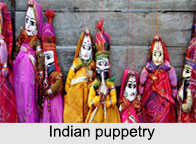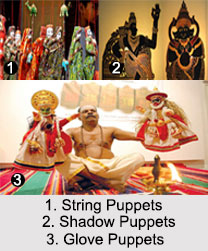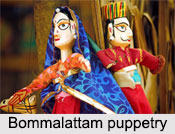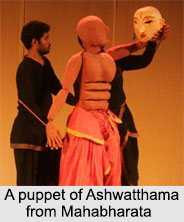 Indian Puppetry is popularly known as "Kathputli" and it is a very old tradition which engrosses the storytelling method through playing the puppets. The puppetry artists roam from place to place to entertain the people by performing the mythological stories, historical romances and so on. The art of puppetry is a very ancient tradition of India and it is regarded to be the universal art. Puppetry has served as a medium for human communication for several years. India is said to be the home of puppets.
Indian Puppetry is popularly known as "Kathputli" and it is a very old tradition which engrosses the storytelling method through playing the puppets. The puppetry artists roam from place to place to entertain the people by performing the mythological stories, historical romances and so on. The art of puppetry is a very ancient tradition of India and it is regarded to be the universal art. Puppetry has served as a medium for human communication for several years. India is said to be the home of puppets.
History of Indian Puppetry
The origin of the art of puppetry can be traced back to India but now it has crossed the geographical boundaries and reached many other countries. The Indian Puppetry was originated around 4000 years ago and there is an evidence of puppetry in Indus valley civilization also. The debate of puppetry is present in the fictional works dating from 1500 years ago.
The "Ashokan" laws were also portrayed on the puppetry. Stick puppets were used to play out in the Indian epics like the Mahabharata and the Bala-Ramayana. Even the "Natyashastra" and the "Kamasutra" explain puppetry in some aspect. The origin of Puppetry is developed from the Latin word "Pupa" meaning a doll. The initial reference to the art of Indian puppetry is found in Tamil classic the "Silappadikaaram" which was written around the 1st or 2nd century B.C.
Types of Indian Puppetry
There are four types of Indian Puppetry and these are glove puppetry, rod puppetry, shadow puppetry and string puppetry. Their categorization are based on different ways of direction of puppets.
 Glove Puppetry: It is also known as "Sleeve", "Hand" or "Palm" Puppetry. In the Glove puppetry, the head of the puppet is made of cloth, wood and paper. The other parts of the puppets are dressed in a long flowing skirt. The puppeteer utilizes three fingers to control the puppets and create a broad range of movements.
Glove Puppetry: It is also known as "Sleeve", "Hand" or "Palm" Puppetry. In the Glove puppetry, the head of the puppet is made of cloth, wood and paper. The other parts of the puppets are dressed in a long flowing skirt. The puppeteer utilizes three fingers to control the puppets and create a broad range of movements.
Rod Puppetry: Rod puppets are an expansion of glove-puppets, although frequently supported and manipulated by rods from below. The rod puppets are controlled by the rods of a variety of types and sizes. These puppets have mainly three joints. The heads which is maintained by the main rod is connected to the neck and both the hands are attached to the rods that are joined by the side of the shoulders. The major holding rod which holds the puppet might be hidden by a shawl or costume of the puppet.
Shadow Puppetry: In shadow puppetry, the puppets are plane and are made of leather and animal covers. They are skilfully coloured and decorated. When these puppets are presented beside the screen with the light behind them, they form the shadows on the screen and those moving shadows are seen by the audience. The strategy between the light and the screen create silhouettes or colourful shadows for the viewers who sit in front of the screen.
String Puppetry: The String puppets are prepared from a single piece of wood and colourful costumes. They do not have legs. Puppeteers attach strings to the fingers of the puppets and complete by manipulating them. String puppets are made of wood or wire or clothes which are stuffed with the cotton, rags or dust. The string puppets are also known as "marionettes" which has a jointed body and limbs.
Themes of Indian Puppetry
Generally the epic stories are used as the themes of the puppet shows and these are manipulated by the strings. The puppets are decorated with vegetable colours, which are locally accessible. The operators or the "Sutradars" stand straight behind the puppets on the stage leaving the stage wings free for the passage of puppets. The peeping from a bamboo with rubber band is tied between the two strips.
Popular Indian states of Indian Puppetry:
Following are the Popular Indian states of Indian Puppetry:
 Karnataka: The "string puppets" of Karnataka are called "Gombeyatta". They are styled and designed like the characters of "Yakshagana", the traditional theatre form of the area.
The "Gombeyatta puppet" figures are extremely stylized. Episodes performed in "Gombeyatta" present the stories based on episodes of epics and puranas. In Kanataka, the shadow puppets are called "togalu" (leather) "gombe-atta" (puppet dance) of Karnataka. These puppets are mainly small in size. The puppets however vary in its sizes according to their social importance, for example, large size is for the kings and the religious characters and the smaller sizes are for the general people or servants.
Karnataka: The "string puppets" of Karnataka are called "Gombeyatta". They are styled and designed like the characters of "Yakshagana", the traditional theatre form of the area.
The "Gombeyatta puppet" figures are extremely stylized. Episodes performed in "Gombeyatta" present the stories based on episodes of epics and puranas. In Kanataka, the shadow puppets are called "togalu" (leather) "gombe-atta" (puppet dance) of Karnataka. These puppets are mainly small in size. The puppets however vary in its sizes according to their social importance, for example, large size is for the kings and the religious characters and the smaller sizes are for the general people or servants.
Assam: In Assam, string puppet illustrates locally as "putal-nach" which is widespread in the plains of Assam. The body and hands of the puppets are made of soft wood. Stories from Indian mythology like Ramayana and Mahabaratha are performed by the puppets.
Kerala: Glove puppets in Kerala are called "Pava-kathakali". The puppets are very multi-coloured and created like a "kathakali" actor who dresses heavily and mask-like facial make-up, headdress and bright costumes. The theme for Glove puppet in Kerala is based on the episodes from both the Ramayana and the Mahabharata.
Odisha: Glove puppets of Odisha are called the "Kundhei nach". These are made of three wooden pieces consisting of the head and the two hands with holes for adding fingers. The wooden pieces are connected in a long flowing costume. In Odisha, the art of Rod Puppetry is known as "Kathi Kandhe". The Odisha Rod puppets are smaller in sizes, generally about twelve to eighteen inches. Stories based on mythology, fantasy and social themes are implemented by the rod puppeteers. Odisha"s "Ravanachhaya shadow puppetry" is the most histrionically exciting puppet show. The string puppets of Odisha are recognized as "Gopalila Kundhei". The string puppets are the light wooden half-dolls from head to waist with removable arms. These puppets have no legs but put on long flowing skirts. They have more joints and therefore, more flexible, expressive and easy to control.
West Bengal: West Bengal has a prosperous tradition of "rod puppetry" called "putul nach". The puppeteers hold a puppet and perform from following a head-high bamboo screen. They move and dance as manipulating the rods attached to the puppets.
Tamil Nadu: "Thol Bommalattam" is the shadow puppets in Tamil Nadu. The puppets are made of goat skin with no damages. Stories from Ramayana and Mahabaratha are performed. Puppets from Tamil Nadu are known as "Bommalattam" that mix the techniques of both rod and string puppets.
Bihar: The usual Rod puppet of Bihar is famous as "Yampuri". These puppets are made of wood. These puppets are in one part and have no joints.
Andhra Pradesh: Andhra Pradesh`s shadow puppet is known as "Tholu Bommalata". "Tholu Bommalata" means the dance of leather puppets. The puppets are brilliantly coloured and are made out of goat skin. These leather puppets are about 5-6 ft. in height and have joints at shoulders, elbows, knees and at times also in the waist, neck and ankles.
Maharashtra: The "Ratnagiri" area of Maharashtra has a shadow puppetry art that is known locally as "Chamadyache Bahulya". These shadow puppets have no connected limbs and are skilfully coloured with vegetable colours. A Maharashtrian string puppet which is on the edge of death is called "Kalasutri Bahulya". The "Kalasutri puppets" are small puppets with no legs. They have only two joints at the shoulders and are controlled by the strings that are attached to the head and hands of the puppet.
Rajasthan: The usual puppets of Rajasthan are known as "Kathputli". Carved from a single part of wood, these puppets are like big dolls that are vibrantly dressed. Strings are attached to the head for planning. The faces are typically painted yellow, white or any light colour.
The art of Indian puppetry is disappearing because of the rising number of entertainment Medias. Nowadays people forget the puppet show as they are more involved in watching entertainment Medias in their extra time. Still the rich heritage of Indian puppetry is surviving and is very popular also.




